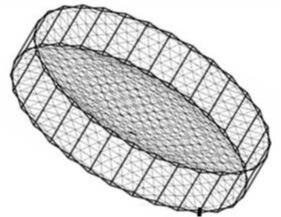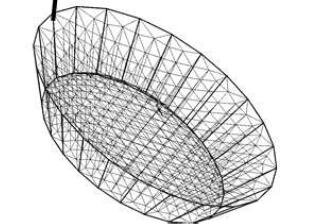Reflector synergies for Telecommunications and Earth Observation missions
Within ESA General Studies Programme's project RESTEO (REflector Synergies between Telecom and Earth Observation) conceptual work has been carried out to identify the most promising reflector desings capable of meeting the requirements of both telecommunication and Earth-observation future missions.
A team lead by Space Engineering (Italy), together with HPS and Technical University of München, identified a potential development of Large Deployable Reflectors in Europe. Increasing demands for improved performance of mobile services are likely to drive the use of large reflectors for telecommunications. This is associated fundamentally to the systems operating either globally or regionally from GEO. Today, Inmarsat 4 covers the globe with 3 satellites, each carrying a 9 meter reflector operating in L-band with 120 element feed system. Alphasat will back-up and extend this scenario using a 12 meter reflector. The North American region is covered with ~500 spot beams by Sky Terra (L-band, 22m antenna) or with ~500 beams by Terrestar (S-band, 18 m antenna).
Earth Observation missions currenlty under study call for a large reflector antenna as well, with Biomass as clear example. Other potential future missions would benefit from a large reflector antenna, to observe for example sea salinity or soil moisture.
The GSP study has investigated possible synergies between telecommunications and Earth-observation missions for such applications in Europe. In particular, the following study objectives have been addressed:
- To assess needs and requirements for large reflector antenna for both Telecom and Earth-observation future missions considering RF, mechanical, thermal and satellite accommodation aspects.
- To trade-off and make concept selections of reflector designs based on European technologies heritage for each antenna requirements.
- To identify possible synergy and commonality as well as differences among these reflectors and to select two reflector concepts allowing to cover the largest range of potential future missions for both Telecom and Earth Observation.
- To perform a preliminary design of these two reflectors considering scalability and possible merging of technologies already developed and to define the testing philosophy.
- To evaluate the compliance for all the antenna requirements as identified in the first task and to perform the development and test plan for the reflectors.

Starting from the overview of the market needs in Telecomm and Earth-observation missions, two classes of reflector have been identified. The most promising concepts able to match market needs have been pointed out, in terms of reflecting surface and peripheral ring. The two concepts are the cylindrical double pantograph and the “V” fold conical ring (see image).

Both architecture are based on metal mesh and peripheral ring structure and they have been investigated in the present project. Both proposed concepts are highly scalable, so applicable for reflectors to be used in EO and TLC missions ranging from P to Ka band frequencies. A denser mesh should be used for Ka band missions even if same materials and knot type can be used.
For further information please contact:
Kees van ‘t Klooster
Study Technical Officer
ESA/ESTEC Electromagnetic & Space Environment Division (TEC/EEA)
T: +31 (0)7 1565 3940
Kees.van.t.Klooster @ esa.int
Andres Galvez
ESA General Studies Programme Manager (PPC-PF)
T: +33 (0)1 5369 7623
Andres.Galvez @ esa.int




